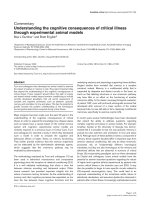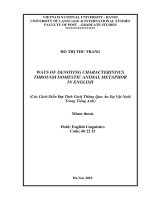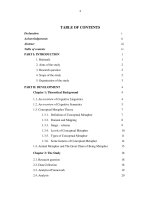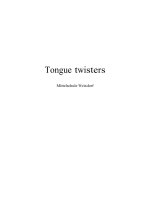Ways of denoting characteristics through domestic animal metaphor in English
Bạn đang xem bản rút gọn của tài liệu. Xem và tải ngay bản đầy đủ của tài liệu tại đây (1.75 MB, 9 trang )
Ways of denoting characteristics through
domestic animal metaphor
in English
Hồ Thị Thu Trang
Trường Đại học Ngoại Ngữ
Luận văn ThS. Chuyên ngành: English Linguistics; Mã Số: 60 22 15
Người hướng dẫn: Dr. Hà Cẩm Tâm
Năm bảo vệ: 2010
Abstract: The thesis investigates different ways of denoting human character traits through
some domestic animal metaphors in English, i.e. Dog, Cat, Chicken, Pig, and Cow. It also
attempts to explore the reasons underlying the association of these domestic animals’ ascribed
attributes with some salient human character traits. Data for the analysis have been gathered
mainly from English dictionaries and corpora. Some Vietnamese instances taken from online
sources are also included, serving as illustrations of how these domestic animal are
conceptualized in Vietnamese language, but a deeper contrastive analysis of domestic animal
metaphors between the two languages is by no means within the scope of the study. The
collected linguistic data are then grouped and analyzed according to the character traits that they
represent. A total of 13 character traits have been discussed in the thesis and the most prominent
character traits associated with Dog, Cat, Chicken, Pig and Cow are summarized. At the end of
the thesis, teaching implications as well as some suggestions for translating texts concerning
animal metaphor are also included.
Keywords: Tiếng Anh; Vật nuôi; Ẩn dụ.
Content:
4
TABLE OF CONTENTS
Declaration i
Acknowledgements ii
Abstract iii
Table of contents iv
PART I: INTRODUCTION 1
1. Rationale 1
2. Aims of the study 2
3. Research question 2
4. Scope of the study 2
5. Organization of the study 3
PART II: DEVELOPMENT 4
Chapter 1: Theoretical Background 4
1.1. An overview of Cognitive Linguistics 4
1.2. An overview of Cognitive Semantics 5
1.3. Conceptual Metaphor Theory 7
1.3.1. Definition of Conceptual Metaphor 7
1.3.2. Domain and Mapping 8
1.3.3. Image – schema 9
1.3.4. Levels of Conceptual Metaphor 10
1.3.5. Types of Conceptual Metaphor 11
1.3.6. Some features of Conceptual Metaphor 14
1.4. Animal Metaphor and The Great Chain of Being Metaphor 15
Chapter 2: The Study 18
2.1. Research question 18
2.2. Data Collection 18
2.3. Analytical Framework 19
2.4. Analysis 20
5
2.4.1. Arrogance 20
2.4.2. Maliciousness 21
2.4.3. Selfishness/ Greediness 24
2.4.4. Stupidity 25
2.4.5. Loose moral 26
2.4.6. Obstinacy 27
2.4.7. Cowardice 28
2.4.8. Servility 29
2.4.9. Smugness 30
2.4.10. Aggressiveness 30
2.4.11. Despicableness 31
2.4.12. Mild-manner 33
.2.4.13. Tenaciousness 33
PART III: CONCLUSION 34
1. Conclusions 34
2. Implications 35
3. Suggestions for further research 36
REFERENCES 37
APPENDIX 40
6
Part I: INTRODUCTION
1. Rationale
Over the past century, English has emerged as an international language with its
influence extending to almost every part of the world and almost fields of life. It is an
indispensable medium for diplomacy, aviation, transaction of international trade, scientific and
technological studies, etc. Accordingly, English teaching and learning are becoming
increasingly important. In Vietnam, there seems to exist a commonly-held assumption among
many English learners that in acquiring a foreign language, such linguistic factors as
grammatical, lexical, phonological etc. rules must be put priority and be the centre of the
learning process. Such assumption, though considered reasonable to certain extent, has
somehow shaped a rigid learning method which heavily focuses on linguistics factors and take
other non-linguistic elements for granted. However, it has been pointed out that if we learn
English without studying, at the same time, the underlying aspects of the language, we are
merely using words which might convey improper senses. A lot of language phenomena are
associated with cultural aspects of the country from which the language stems, and some also
reflect the specific way of viewing and experiencing the world of people of that country.
Metaphor is one such phenomenon.
Metaphor is traditionally considered a figure of speech, an ornamental device that is
restricted to literature and poetry and “exclusive with the realm of ordinary everyday
language” (Lakoff, 1993, p. 202). In recent decades, with the increasing interest of cognitive
researchers in the subject, metaphor has been re-defined as a cognitive system that structures
our thoughts and behavior rather than a language phenomenon, hence the term “conceptual
metaphor”. According to cognitive linguistics, a conceptual metaphor is a mapping of the
structure of a source domain onto a target domain, in which the target domain is understood in
terms of the source domain. It acts as a powerful thinking mode in which people use their
familiar, material and concrete concepts to know, think about and experience immaterial
concepts which are difficult to be realize, thus obtain better understanding about themselves
and the outside world.
7
Out of the human world, there is a colourful animal world which is closely related with
our life. The “neighbour” relationship between human and animals makes people very familiar
with the habits of animals, and gradually they begin to associate some animals’ characters
with someone’s characters, hence “PEOPLE ARE ANIMALS” metaphor. Metaphorical
transfer from animal domain to human domain is considered universal and can be found in
many languages, including English and Vietnamese. However, although the same animal
metaphor may occur in the two languages, it does not mean that the concept represented by
that metaphor in English is totally identical to that in Vietnamese and vice versa. The
difference in the perception of each language community toward an animal metaphor may
cause difficulties for English learners in both learning and translating process. Therefore, a
good understanding of how an animal protypical atrribute is used to talk about a human trait in
a certain language not only helps English learners use it properly but also offers them
opportunity to get to the heart of English culture. For this reason, the study will attempt to
explore how animals related expressions are used to denote human characteristics in English
and Vietnamese. As it would be an exhausive work if all animal terms are investigated, the
study will limit itself to analyze just some domestic animals that are common in both everyday
life and language, namely Dog, Cat, Chicken, Pig, and Cow.
2. Aims of the study
The study aims at
- Investigating different ways of denoting human character traits through Dog, Cat,
Chicken, Pig, and Cow metaphors in English.
- Identifying the symbolism of Dog, Cat, Chicken, Pig and Cow in association with
human character traits as encoded in English.
3. Research question
To realize the above aims, the following research question will be addressed:
How are salient human characteristics denoted through the Dog, Cat, Chicken, Pig
and Cow metaphor in English?
8
4. Scope of the study
The study examines a group of domestic animal metaphors. Within the domestic animal
source domain, five sub-domains are chosen: dog, cat, chicken, pig and cow. When a
comparison between humans and animals is made, different features of animals such as
physical appearance features, sounds, and prototypical behaviours can be respectively mapped
onto human domain. In this thesis, the foci will be on those metaphors that describe human
characteristics.
5. Organization of the study
The study consists of three parts. The first part “Introduction” gives a brief account of
the rationale, scope, aims, research questions and organization of the study. The second and
also the main part of the study, “Development”, consists of two chapters:
Chapter 1: Theoretical background, which provides an overview of conceptual
metaphor such as its definition, levels, types and features as well as other central concepts to
understand conceptual metaphor like domain, mapping and image-schema.
Chapter 2: The study. This chapter restates the research question, briefly describes the
data collection procedure as well as presents the analytical framework. The main focus of this
chapter is a discussion on the usage of different expressions with Dog, Cat, Chicken, Pig, and
Cow to denote human characteristics in English.
The last part is “Conclusion”, which summarizes the main findings; draw important
conclusion and offers suggestions for further studies.
The study ends with “Reference” and “Appendix”
42
REFERENCES
In English
1. Baider, F. and Gesuato, S. (2003). Masculinist metaphors, feminist research. The Online
Journal Metaphorik.de 5, 6-25.
Kövecses, Z (2002). Metaphor: A practical guide. Oxford: Oxford University Press.
2. Deignan, A. (1995). Collins Cobuild Guides to English 7: Metaphor. London:
HarperCollins.Jackendoff, R. (1983). Semantics and Cognition. Cambridge: MIT Press.
3. Deignan, A. (2005). Metaphor and Corpus Linguistics. Amsterdam & Philadelphia: John
Benjamins
4. Deignan, A. (2006). "The grammar of linguistic metaphors." in: A. Stefanowitsch and S.
Gries (Ed.) Corpus-Based Approaches to Metaphor and Metonymy. (Trends in Linguistics.
Studies and Monographs 171). Berlin and New York: Mouton de Gruyter.
5. Evans, V. and Green, M. (2006). Cognitive Linguistics: An Introduction. Routledge.
6. Geeraerts, D. (2006). Cognitive Linguistics: Basic Readings. Berlin/New York: Mouton de
Gruyter
7. Hsieh, Sh.Ch. (2003). The Corpus of Mandarin Chinese and German animal expressions
[in:] D.Archer, P. Rayson, A. Wilson and T. McEnery (eds), Proceedings of the Corpus
Linguistics 2003 Conference. Lancaster: Lancaster University, pp. 332–341.
8. Jäkel, O. (2002). Hypotheses Revisited: The Cognitive Theory of Metaphor Applied to
Religious Texts. The Online Journal Metaphorik.de 02/2002.
9. Johnson, M. (1987). The Body in the Mind: The Bodily Basis of Meaning. Chicago: The
University of Chicago Press.
10. Kiełtyka, R. and Kleparski, G.A. (2005). The scope of English zoosemy: The case of
DOMESTICATED ANIMALS. Studia Anglica Resoviensia 3, 76-87.
11. Kiełtyka, R. and Kleparski, G.A. (2005) ‘The ups and downs of the Great Chain of Being:
The case of canine zoosemy in the history of English’. SKASE Journal of Theoretical
Linguistics. 2, 22–41.
12. Kövecses, Z. (2005). Metaphor in culture: universality and variation. Cambridge:
Cambridge University Press
43
13. Langacker, R. W. (1987) Foundations of Cognitive Grammar: Theoretical Prerequisites.
Stanford, CA: Stanford University Press.
14. Langacker, R. W. (1991). Foundations of Cognitive Grammar, Volume II, Descriptive
Application. California: Stanford University Press,
15. Lakoff, G., & Johnson, M. (1980). Metaphors we live by. Chicago: University of Chicago
Press.
16. Lakoff, G. (1987). Women, Fire, and Dangerous Things: What categories reveal about the
mind. Chicago: University of Chicago Press.
17. Lakoff, G., & Turner, M. (1989). More than cool reason: A field guide to poetic metaphor.
Chicago: University of Chicago Press.
18. Lakoff, G. (1993). The contemporary theory of metaphor. In A. Ortony (Ed.), Metaphor
and thought, 2nd ed. (pp. 202-251), Cambridge: Cambridge University Press.
19. Palmatier, R. (1995). Speaking of Animals: A Dictionary of Animal Metaphors (SOA).
Westport: Greenwood Press.
20. Rodriguez, I. L. (2009). Of Women, Bitches, Chickens and Vixens: Animal Metaphors for
Women in English and Spanish. Culture, language and representation, vol. vii\2009, pp. 77-100.
21. Talebinejad, M. R. and Dastjerdi, H.V. (2005). A cross-cultural study of animal
metaphors: When owls are not wise! Metaphor and Symbol 20: 133-150.
22. Talmy, L. (2000). Toward a Cognitive Semantics. Cambridge: MIT Press.
23. Ungerer, F. & Schmid, H-J. (1996). An introduction to cognitive linguistics. London:
Longman.
24. Wierzbicka, A. (1988).The semantics of grammar . Amsterdam: John Benjamins.
In Vietnamese
25. Dương Kỳ Đức. (2003). Dê ta và Dê Tây. Ngôn ngữ và Đời sống, số 1+2 (87+88). Hội
Ngôn ngữ học Việt Nam
26. Dương Kỳ Đức. (2005). Gà ta và Gà Tây. Ngôn ngữ và Đời sống, số 1+2 (111+112). Hội
Ngôn ngữ học Việt Nam
27. Dương Kỳ Đức. (2006). Chó ta và Chó Tây. Ngôn ngữ và Đời sống, số 1+2 (123+124).
Hội Ngôn ngữ học Việt Nam
44
28. Nguyễn Đức Tồn. (2008). Đặc trưng tư duy của người Việt qua ẩn dụ tri nhận trong thành
ngữ. Ngôn ngữ số 12. Viện ngôn ngữ học.
29. Nguyễn Lân (2002). Từ điển thành ngữ và tục ngữ Việt Nam. NXB Văn học
30. Nguyễn Lực và Lương Văn Đang. (1993). Thành ngữ tiếng Việt. NXB Khoa học xã hội Hà
Nội
31. Trần Ngọc Thêm. (1999). Cơ sở văn hóa Việt Nam. NXB Giáo dục
Online sources









